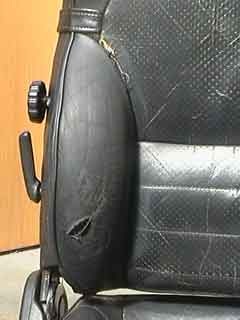Leather car seats, while luxurious and comfortable, are susceptible to wear and tear over time. One common issue car owners face is small tears in the leather, often caused by friction, sharp objects, or general aging. A tear, even if small, can detract from your car’s interior appeal and potentially worsen if left unattended. Fortunately, repairing a small tear in your leather car seat is a manageable DIY project that can save you money compared to professional upholstery services.
This comprehensive guide will walk you through each step of repairing a small tear in your leather car seat, ensuring a professional-looking finish. By following these instructions and using the right products, you can restore the beauty and integrity of your car’s leather interior.
Products Required for Leather Car Seat Repair
Before you begin, gather the necessary products. These are commonly available in leather repair kits, which are convenient and cost-effective for DIY repairs.
- Leather Prep: To clean and prepare the leather surface for repair.
- Abrasive Pad: Used with leather prep to remove finishes and create a better bonding surface.
- Alcohol Cleaner: To further clean the leather and remove any residue.
- Scalpel or Scissors: For tidying up the torn area.
- Leather Repair Sub-Patch: To provide a backing and support for the repair.
- Tweezers: To help position the sub-patch under the leather.
- Leather Glue: To adhere the sub-patch and leather edges.
- Spatula or Palette Knife: For applying leather glue and filler.
- Heavy Filler: To fill the tear and level the repair area.
- Colorant: Matched to your car seat’s leather color to conceal the repair.
- Sponges: For applying colorant.
- Airbrush (Optional but Recommended): For a smooth and even colorant application, especially for larger repairs.
- Leather Finish: To seal and protect the repaired area, ensuring durability.
- Hair Dryer (Optional): To speed up drying times for filler and colorant.
- Sandpaper (Optional): For smoothing out overfilled areas.
You can often find these items in a comprehensive Leather Car Seat Repair Kit (replace with actual link to a relevant product category page if available).
Leather Car Seat Repair Method: Step-by-Step Guide
Follow these steps carefully to effectively repair a small tear in your leather car seat.
Step 1: Prepare the Leather Car Seat
The first crucial step is to thoroughly prepare the leather surface around the tear. Use the Leather Prep and abrasive pad provided in your repair kit. Gently rub the abrasive pad soaked with Leather Prep over the area surrounding the tear. This process removes surface grease, oils accumulated from use, and any loose fibers. Critically, it also removes the original manufactured finish on the leather. Removing this finish is essential as it allows the colorant, which you’ll apply later, to properly adhere to the leather for a long-lasting repair.
After using the Leather Prep, wipe down the area with the Alcohol Cleaner. This step ensures the removal of any remaining dirt, dust, or residue from the prepping process, providing a clean surface for the subsequent repair steps. A clean surface is vital for optimal adhesion of repair materials.
Step 2: Tidy the Torn Area
Examine the tear closely. You’ll likely notice that the edges of the tear protrude slightly outwards, forming a lip. This lip can compromise the smoothness and overall quality of your repair, making the tear noticeable even after repair. Therefore, it’s important to remove this lip.
Using a scalpel or sharp scissors, carefully trim away this protruding lip. Cut at the base of the lip, making sure to remove the excess leather cleanly. Exercise caution during this step to avoid accidentally damaging the surrounding leather that is not part of the tear. The goal is to create a clean, even edge around the tear for a seamless repair.
Step 3: Apply the Backing Patch
To provide a solid foundation for the filler and ensure a durable repair, a leather repair sub-patch is necessary. Take the canvas patch provided in your repair kit and cut it to a size that adequately covers the tear with an extra margin of about 1 cm (approximately 0.4 inches) extending beyond the tear’s edges on all sides. This extra material will go underneath the leather surrounding the tear.
Using tweezers, carefully insert one edge of the cut patch underneath the leather, ensuring the 1cm excess is positioned beneath the leather. Hold this edge in place and gently guide the rest of the patch under the remaining edges of the tear. The goal is to position the patch flat underneath the tear, with the 1cm margin secured beneath the leather all around the tear.
Once the patch is correctly positioned, apply a small amount of Leather Glue onto the spatula. Carefully feed the spatula underneath the edges of the tear to apply glue to the underside of the leather that will adhere to the patch. Be careful not to displace the canvas patch while applying glue. After applying glue to all edges, apply pressure to bond the leather to the patch. Hold pressure for a few moments to ensure good adhesion and then allow the glue to dry completely according to the manufacturer’s instructions.
Step 4: Fill the Hole with Heavy Filler
With the backing patch securely in place, you can now begin filling the tear. Use the Heavy Filler from your repair kit. Using the end of the palette knife, take a small amount of filler and apply a very thin layer directly into the tear, covering the sub-patch. It’s crucial to apply thin layers. Ensure the layer is just thick enough to cover the patch and the tear area. Allow this first layer to dry for approximately 20 minutes. You can use a hair dryer on a low, cool setting to speed up the drying process.
Continue applying the heavy filler in thin layers. Applying multiple thin layers is crucial because heavy filler tends to shrink as it dries. Thick layers may not cure properly and can lead to cracking or an uneven repair. As a general guideline, aim for at least 5-6 thin layers to gradually build up the filler until it reaches just below the surface level of the surrounding leather.
After applying each layer, and before drying, smooth out any excess filler using the sharper edge of the palette knife. This helps to create a smooth, even surface and reduces the amount of sanding needed later.
Step 5: Continue Building Filler Layers
This image illustrates the appearance of the repair after approximately 5 or 6 thin layers of filler have been applied. At this stage, the hole will be mostly filled, but the surface will likely not be completely smooth. Continue applying thin layers of filler as described in Step 4, allowing each layer to dry and smoothing out excess filler after each application. The goal is to gradually build up the filler to the correct level.
Step 6: Apply the Final Layer of Filler for Leveling
For the final layer of filler, aim to completely fill the tear so that the filler is level with the surrounding, undamaged leather of the car seat. Take care to allow this final layer to cure fully and properly. If the filler is not fully cured, it may shrink excessively, resulting in the filler sinking below the level of the surrounding leather and requiring further application.
If, after drying, you find that the filler has shrunk and is below the desired level, simply apply another thin layer of filler to bring it level. If you accidentally apply too much filler and it extends onto the surrounding leather, carefully remove the excess using the palette knife before it dries.
Your objective is to achieve a perfectly level fill, flush with the original leather surface, without overfilling. If you do slightly overfill, you can carefully reduce the excess once fully dried using fine-grit sandpaper, being very gentle to avoid scratching the surrounding leather.
Once you are satisfied with the level of the filler and can no longer feel any ridge or unevenness between the filler and the original leather, clean the entire repair area again with the Alcohol Cleaner. This removes any dust or unwanted filler residue from the surrounding area, preparing it for the colorant.
Step 7: Apply an Initial Coat of Colorant
The colorant included in your repair kit should be a close match to the original color of your leather car seat. If you are undertaking a complete recoloring project, you would use a different colorant accordingly.
Take one of the sponges from the kit and apply a small amount of colorant to it. Thoroughly rub this colorant into the repaired area. This initial application is designed to penetrate into the natural creases of the leather grain and any small valleys or textures, ensuring good color coverage and a better overall finish. Work the colorant into the area using circular motions and light pressure.
After this initial application, proceed to the next step for spray application of the colorant, which provides a more even and professional finish.
Step 8: Finish the Job with Spray Colorant and Finish
For the best and most even color coverage, use an airbrush to spray thin coats of colorant over the repaired leather car seat area. Blend the colorant slightly outwards, beyond the immediate repair, to seamlessly integrate the repaired section with the surrounding original leather color.
Apply multiple thin coats of colorant rather than one or two thick coats. Allow each coat to dry sufficiently before applying the next. This is crucial for achieving an even, professional finish and prevents issues with uncured colorant, such as tackiness or runs. Depending on the severity of the initial damage, the color, and the desired level of concealment, it may be necessary to apply between 10 and 15 thin coats of colorant for optimal results. Patience and thin coats are key to a high-quality repair.
Once you are satisfied with the color coverage, the repair is well-concealed and blended, and the final colorant coat is completely cured, it’s time to apply the leather finish. Using the spray gun (or a sponge if spray finish is not available in your kit and instructions permit sponge application), apply 4 to 5 thin coats of the leather finish over the repaired area and slightly beyond, blending into the surrounding leather. Again, allow each coat of finish to dry fully before applying the next.
The leather finish is essential as it seals the colorant, protecting it from wear and abrasion during regular use and significantly prolonging the life of the repair. After the final coat of finish has been applied and is dry to the touch, allow the repaired car seat to sit for a full 24 hours before using it. This ensures that the filler, colorant, and finish are completely cured and hardened, resulting in a durable and long-lasting repair.
By following these steps, you can effectively repair small tears in your leather car seats, maintaining the beauty and value of your vehicle’s interior.
After

